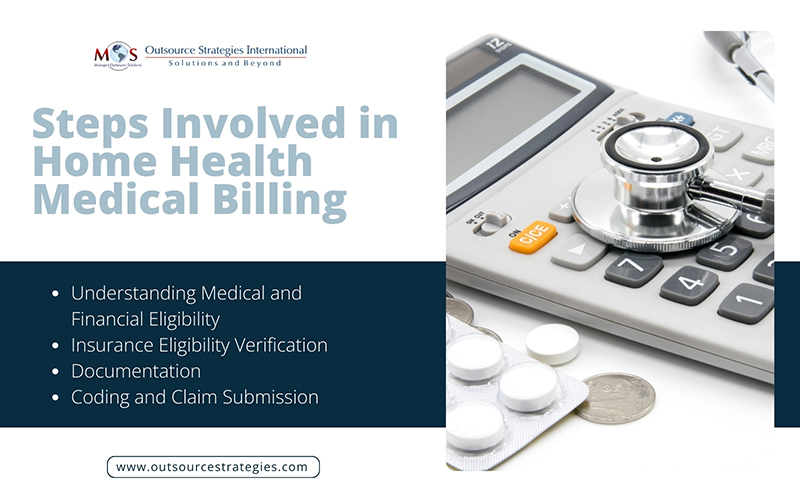The number of Americans aged 65 and older is projected to rise from 58 million in 2022 to 82 million by 2050, a 47% increase, according to the Population Reference Bureau. Home health services provide high-quality, individualized care for patients of all ages within the comfort of their homes or communities. These services include a wide range of offerings, including diagnosis, treatment, nursing care, physical therapy, occupational therapy, speech therapy, medical social services, and assistance from health aides for basic personal needs. The primary goal is to enhance patients’ physical functioning and overall well-being. Revenue cycle management for home healthcare providers plays a crucial role in ensuring that healthcare providers are fairly compensated for delivering this essential care.
Need help with home health billing?
Contact us today to optimize your revenue cycle management!
How Home Health Medical Billing Works
Billing for home health medical billing involves several steps:
- Understanding Medical and Financial Eligibility for Home Health Care
To qualify for home health care, a patient must first be evaluated by a physician to confirm they meet the required criteria. Typically, this includes being “homebound” due to a medical condition and needing intermittent skilled nursing care, physical therapy, occupational therapy, or speech therapy.
Once eligibility is established, the next step is assessing the financial responsibility for care.
- Private Insurance: Often covers a portion of the costs, depending on the specific plan benefits.
- Medicare: Covers services like skilled nursing and therapy if the patient meets the homebound requirement.
- Medicaid: May provide coverage for additional services, with benefits varying by state.
Understanding both medical and financial eligibility is essential to ensuring smooth access to home health care and reducing home health billing errors.
- Insurance Eligibility Verification
The next step is verifying the patient’s eligibility to ensure that services provided are covered by the patient’s insurance. It involves verifying:
- Patient demographic information
- Active coverage
- Policy limitations, and exclusions
- Home health benefits: skilled nursing, therapy services (physical, occupational, speech) and aide assistance
- Prior authorization requirements
- Whether the provider is in-network or out-of-network
- Patient financial responsibilities: copayments, deductibles, coinsurance
Eligibility for ongoing services should be verified as the patient’s insurance or plan can change during treatment. Accurate verification is key to ensuring services are covered, helping to avoid claim rejections and payment delays.
- Documentation
Precise and detailed clinician documentation is the mainstay of every billable service. Factors such as the patient’s medical condition, physician certification, homebound status, and the specific services required need to be carefully documented. The documentation should include thorough visit notes, completed OASIS assessments for Medicare patients, physician orders, care plans, and records of any changes in the patient’s condition or treatment. Capturing all aspects of the patient’s condition, treatments, interventions, and progress, continuity of care and effective communication between all involved healthcare professionals not only provide a clear path for clinical care but also establish compliance for audits.
- Coding and Claim Submission
Submitting claims for home health services requires careful attention to coding, documentation, and payer-specific requirements.
The CPT codes for Home Health Procedures and Services includes codes for E/M Home Visits, Home Visit Services and Home Infusion Procedures and Services.
E/M home visits
Home or residence E/M services, new patient
99341, straightforward medical decision making (MDM) or at least 15 minutes total time,
99342, low level MDM or at least 30 minutes total time,
99344 (code 99343 has been deleted), moderate level MDM or at least 60 minutes total time,
99345, high level MDM or at least 75 minutes total time.
Home or residence E/M services,, established patient
99347, straightforward MDM or at least 20 minutes total time,
99348, low level MDM or at least 30 minutes total time,
99349, moderate level MDM or at least 40 minutes total time,
99350, high level MDM or at least 60 minutes total time.
Home Health Procedures and Services
99500-99600 – Home Visit Services
- 99500: Home visit for prenatal monitoring and assessment.
- 99501: Home visit for postpartum care and evaluation.
- 99502: Home visit for newborn care and assessment.
- 99503: Home visit for respiratory therapy care.
- 99504: Home visit for the initiation of home infusion therapy.
- 99505: Home visit for stoma care and maintenance.
- 99506: Home visit for catheter care and maintenance.
- 99507: Home visit for care and maintenance of tracheostomy.
- 99511: Home visit for fecal impaction management and enema administration.
- 99600: Unlisted home visit service or procedure (used for services not otherwise specified).
These codes are often used when patients require skilled services delivered in their home setting, typically as part of ongoing care or specific treatments. Proper documentation is crucial to justify the services billed under these codes.
99601-99602 – Home Infusion Procedures and Services
- 99601: Home infusion/specialty drug administration, per visit (up to 2 hours).
- 99602: Each additional hour (list separately in addition to the code for primary service).
These codes are used for the professional services provided by a healthcare professional administering infusion or specialty drugs in a patient’s home. 99601 covers the first two hours of the visit, while 99602 is used for additional time beyond that.
Proper documentation includes the type of drug administered, duration of the service, and any related procedures performed during the visit. Supplies, equipment, and the drug itself are typically billed separately.
In addition to the CPT codes, claims should include the appropriate ICD-10 codes and the correct HCPCS codes for home health procedures and supplies (e.g., G0151-G0156 for skilled nursing or therapy). ICD-10 and CPT coding accuracy is crucial to prevent denials.
Follow Medicare guidelines. Medicare reimburses based on the Patient-Driven Groupings Model (PDGM), factoring in the patient’s clinical characteristics and resource use. Other payers may follow fee schedules or negotiated rates.
Medicare is billed under Part A if the patient qualifies for the home health benefit. For non-qualifying services, billing may be under Part B using HCPCS codes. Ensure the 60-day certification period is supported with physician updates when applicable.
The claim submission process usually involves submitting claims electronically via clearinghouses or direct payer portals. Claims should follow the correct format (e.g., UB-04 for institutional claims) and submitted to meet timely filing deadlines. Using advanced billing software helps streamline operations and reduce errors.
- Payment Posting and Reconciliation
Once a payment is received, it is posted in the system, specifying the amount applied to each service and identifying any adjustments, denials, or underpayments. The reconciliation process ensures that the total payments match the amount expected, according to the claims submitted and insurance contracts. It also involves reviewing and resolving discrepancies, such as partial payments or denials, by following up with payers to ensure full reimbursement.
- Follow-up and Denial Management
After claim submission, contact payers when necessary to ensure outstanding claims are addressed. This proactive strategy maintains revenue flow and helps avoid denials and payment delays.
The medical billing process also includes denial management to identify and resolve problems that lead to medical claim denials. Denials need to be appealed, tracked and resolved. There are various reasons why claims may be denied. Managing denials requires implementing effective prevention strategies, which includes analyzing the root causes and taking corrective steps such as retraining staff, adjusting workflows or revising processes.
- Collecting Patient Balances
With the prevalence of high-deductible health plans, patient financial responsibility has increased significantly. Collecting patient balances involves ensuring that any amount not covered by insurance, such as copayments, deductibles, or coinsurance, is collected from the patient. Patients should be informed about their financial responsibilities upfront, including potential out-of-pocket costs based on their insurance coverage. It’s important that they understand their billing statements. Efficient collection processes ensure financial stability for your agency while minimizing patient confusion or dissatisfaction.
Challenges of Billing for Home Health Services
Accurate and compliant billing is key to getting paid properly, but billing for home health comes with its own set of challenges.
Complex billing and reimbursement: Home health services involve billing for various types of services, each with specific codes, documentation standards, and regulatory requirements.
Patient eligibility: Patient eligibility is a common reason for claim denials. Determining patient eligibility for home health services can be challenging as it is governed by complex criteria set by insurers and government programs like Medicare and Medicaid. Frequent changes in regulations and payer-specific guidelines add to this complexity, making accurate home healthcare insurance verification critical for ensuring patients receive the care they need while avoiding claim denials. The need for prior authorizations further complicates the reimbursement process.
Changing rules and regulations: Home health agency billing regulations are constantly changing, and software and electronic health records (EHR) systems should be updated regularly.
Delayed payments: With the need to submit detailed patient records, physician certifications, and ensure compliance with payer-specific regulations, claims processing can be delayed. Providers may struggle to receive payments promptly after services are delivered.
Billing errors: Inaccurate coding, incomplete claims, and submission discrepancies are common errors that can occur billing home health services.
The shift to the Patient-Driven Groupings Model has also brought about major changes in billing practices and revenue cycle management, impacting home health care. This transition requires home health agencies to adapt by updating documentation, coding, and billing procedures to ensure proper reimbursement. Additionally, agencies must closely manage the timing and accuracy of claims to align with PDGM guidelines, which focus on more detailed patient assessments and cost-effective care delivery.
Having expert support can resolve these challenges.
Simplify Home Health Medical Billing with Expert Support
Partnering with a medical billing company for specialty practices is the best way to ensure accurate and timely home health billing. Experts can guide you through best practices, streamlining processes to reduce payment turnaround times and optimize cash flow. With professional home health reimbursement solutions, you can focus on what matters most—delivering quality care to more patients without the burden of billing complexities.
Reduce billing errors and improve cash flow with our expert home health billing services!





